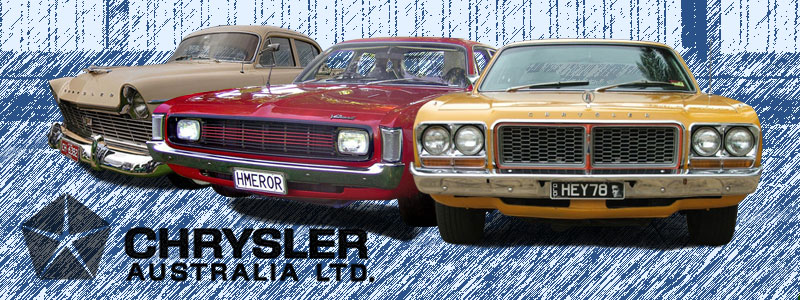In
1951 Chrysler Australia came into being when the American company bought a controlling interest in Chrysler
Dodge Distributors (Australia) Pty Ltd. This previously wholly owned Australian company had been formed in 1935. It was the result of eighteen Chrysler distributors getting together to improve their bargaining position with Detroit. Previously each had dealt independently. Soon after Chrysler-Dodge Distributors was formed, it bought a controlling Interest in T.J. Richards and Sons, the Keswick, South Australian body builders. Richards and Sons had been designing and building bodies for Imported Chrysler chassis. In 1937 they produced the first Australian all steel body before Holden. When
Chrysler Corporation took over, it was with the intention of expanding operations In Australia aiming at an eventual 90% local content. This intention was actually announced before Ford made Its plans public, but Chrysler took considerably longer to get things under way. Meanwhile part manufacture and assembly of
Chrysler Royal and
Dodge Phoenix progressed.
In
1958 Chrysler took over 30% of Simca and began importing various examples of the French make. The first Valiant was announced in 1959 in the US, but it wasn't until 1962 that it made its appearance in Australia, assembled hers fror CKD kits. Less than 1100 were available so demand far exceeded supply, but further plans included $36 million expansion soon after the first locally manufactured Valiants appeared late in
1962. This was aimed at 50,000 units a year. In
1961 Chrysler sold 6,878 units of all makes in a market total lire 237,611 units. When the Valiants went into production this increase; to 16,921 units in a 323,546 unit market. Year by year Chryslers market share increased and in
1964 Tonsley Park in Adelaide was opened as a means of reaching this 50,000 unit goal.
In
1965 Chrysler took over
Rootes Limited bringing
Hillman and Humber cars, together with Commer trucks under Its wing In Australia. It also acquired Rootes Port Melbourne factory, although little by little its facilities were transferred to South Australia, leaving what remained for use by
Australian Motor Industries - and ultimately
Toyota. In
1966 the Lonsdale engine plant was going ahead well near Adelaide and things were looking rosey for Chrysler's biggest assembly facility outside North America, under the guidance of managing director David Brown. By
1967 Chrysler Australia had 13.5% of the Australian market and was third of the "Big Three",
General Motors Holden, Ford and Chrysler. In some months it even beat Ford, but this success did not to last.
Sales began to decline in the late sixties and to bolster things a deal concluded with
Mitsubishi to assemble the Galant. Despite every effort Chrysler fortunes continued to go from bad to worse until
1977 when ever increasing ties with Mitsubishi saw the Sigma enter local production. Sigma's star rose, so Valiants dropped closer to the horizon, and Mitsubishi increased its ownership of Chrysler Australia. The closing stages of the Japanese takeover saw Chrysler's complete assimilation and change the name to
Mitsubishi Motors Australia. The final act came on August
1981 when the last link with Chrysler was cut and the 565,338th crept off the Tonsley Park line. Undoubtedly, towards the end, the Valiant was a severe embarrassment to the Japanese, but it was, in its final form, a pretty good car. To many Australians its final demise was a sad occasion.
Also see: Chrysler Australia History |
The History of Chrysler (USA Edition)



